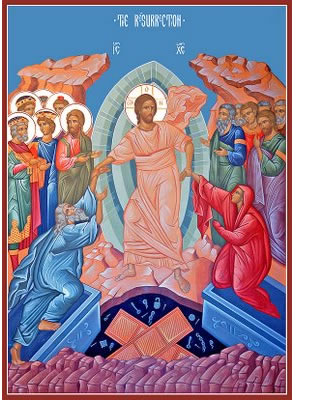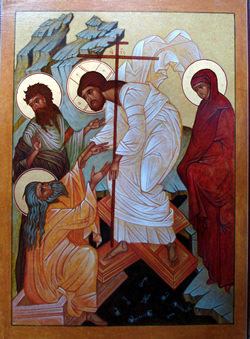|
|||
|---|---|---|---|
| This weekly bulletin insert complements the curriculum published by the Department of Christian Education of the Orthodox Church in America. This and many other Christian Education resources are available at http://dce.oca.org. | |||

Across the world, in countless churches and in many languages, Orthodox Christians proclaim the greeting of Pascha and its confident response, "Indeed He is Risen!" This day also marks the beginning of the period during which we sing joyous words to the Mother of God: "The angel cried to the Lady full of grace, 'Rejoice, O Pure Virgin! Again I say, rejoice. Your Son is risen from His three days in the tomb. With Himself He has raised all the dead. Rejoice, rejoice all ye people!' " These words of the hymn establish the communion between Christ, His mother the Theotokos, and us His people. They remind us that Mary rejoices in a special way: as a loving mother. After the anguish of seeing her Son suffer and die, He has risen in triumph over death. We, His people, rejoice because as He rose He raised us all from the final power of death. Of course, Mary too is one of "the people" because like the rest of us she stands in need of salvation. But she is also the one and only Birthgiver of God. In the centuries following the Resurrection, the Orthodox Church acknowledged this communion between Christ, His mother, and us in many ways. One example is the commemoration of the the Icon of the Life-Giving Spring. In a grove of cypress trees near Constantinople was a garden dedicated to the Mother of God. The garden contained a miracle-working spring. As years went by, the area became overgrown and the spring water got muddy. One day, in the fifth century, a soldier named Leo came upon an exhausted blind man who had lost his way. Wanting to help, Leo looked around for water but could find none. He heard a gentle voice directing him to the nearby spring and telling him not only to give the man water but to apply some of the spring's mud to the man's eyes. He did so, and the man regained his sight. 
When Leo later became Emperor, he remembered the loving voice of the Theotokos and the miracle of healing. He had the spring and its surroundings cleaned, and built a chapel there. Over the following centuries, the chapel would be destroyed more than once (its bricks one time being used to build a mosque), and the spring would be filled in with earth. But each time, local Christians repaired the site and continued to draw water. The icon shows the Mother of God standing with her Son in a large chalice, from whose sides healing water pours. She is once again with her beloved Son, now risen, and that is why we sing to her, "Rejoice, O Pure Virgin." The Son and the Mother of God together bless us with healing and grace. And that is why we sing to each other and to the whole world, "Rejoice, all ye people." |
|||
